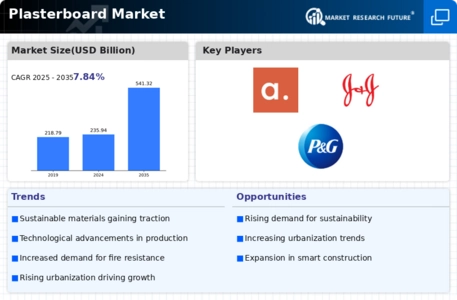Top Industry Leaders in the Plasterboard Market

Plasterboard, the humble hero of interior walls, holds more than just paint and picture frames. This seemingly mundane material. Yet, beneath this seemingly smooth surface lies a dynamic and competitive landscape where giants clash with niche players, all vying for a slice of the plasterboard pie. Let's delve into the strategies, trends, and recent developments shaping this fascinating market.
Strategies Building Market Share:
-
Beyond the Standard Sheet: Leading companies like Knauf and USG Corporation are expanding their offerings beyond traditional drywall, venturing into specialty plasterboard options for fire resistance, moisture, and acoustic insulation, catering to diverse construction needs. -
Sustainability Spotlight: Green credentials are the new building code. Saint-Gobain is leading the charge by developing recycled paperboard and gypsum-based plasterboard solutions, aligning with environmental regulations and eco-conscious consumers. -
Technological Twists: Innovation keeps the walls from cracking. CertainTeed is pioneering lightweight and high-strength plasterboard formulations, improving building efficiency and safety. -
Geographic Expansion: Emerging markets like China and India present fertile ground for growth. Knauf Gypsum, for instance, has established production facilities in these regions to capitalize on the booming demand for affordable and readily available plasterboard. -
Vertical Integration: Gaining control of the supply chain is crucial. USG Corporation is acquiring gypsum mines and investing in advanced manufacturing technologies, ensuring quality control, cost-effectiveness, and independence from external suppliers.
Factors Shaping Market Share:
-
Board Type Matters: Different types cater to specific needs. Standard drywall dominates due to its affordability and versatility, while fire-resistant and moisture-resistant boards find application in specialized areas. National Gypsum excels at offering a diverse range of board types tailored to specific construction projects. -
Regional Trends: Building codes and cultural preferences influence market dynamics. Europe, for example, favors thinner plasterboard due to space constraints, while the US market leans towards thicker options for enhanced soundproofing. LafargeHolcim adapts its offerings to regional regulations and preferences. -
Cost Competitiveness: Price remains a crucial factor, particularly for large-scale projects. Asian manufacturers often offer cost-effective options, while European and American players command premium prices for high-performance, specialized plasterboard solutions. Georgia-Pacific Gypsum focuses on balancing affordability with quality and innovation. -
Sustainability Regulations: Stringent environmental regulations on resource extraction and carbon emissions impact market dynamics. The European Union's Emissions Trading System, for instance, incentivizes the use of recycled materials in plasterboard production. -
Technology Advancements: New production techniques, lightweight formulations, and even self-finishing plasterboard solutions can disrupt the market. CertainTeed, for example, is exploring the use of 3D printing technology for on-site plasterboard production, potentially revolutionizing construction processes.
Key Players:
- Armstrong World Industries Inc. (US)
- Etex Group (Belgium)
- Saint-Gobain SA (France)
- Gypsum Management and Supply Inc. (the US)
- USG Corporation (US)
- Georgia Pacific LLC (US)
- Boral Limited (Australia)
- KNAUF Gips KG (Germany)
- Fletcher Building Limited (New Zealand)
- LafargeHolcim Ltd (Switzerland)
Recent Developments:
August: USG Corporation unveils a novel fire-resistant plasterboard that withstands higher temperatures for longer durations, potentially changing fire safety standards in construction.
September: The European Union proposes stricter regulations on dust emissions from gypsum mines, prompting plasterboard manufacturers to invest in dust control technologies.
October: China announces a major infrastructure development plan, boosting demand for high-quality and affordable plasterboard for new buildings and renovations.
November: A consortium of plasterboard manufacturers and environmental organizations launches a research initiative to develop standardized sustainability and life cycle assessment protocols for the industry, promoting transparency and responsible sourcing.
December: A promising startup develops a bio-based adhesive derived from algae that significantly reduces the environmental impact of plasterboard production, potentially revolutionizing the industry.

